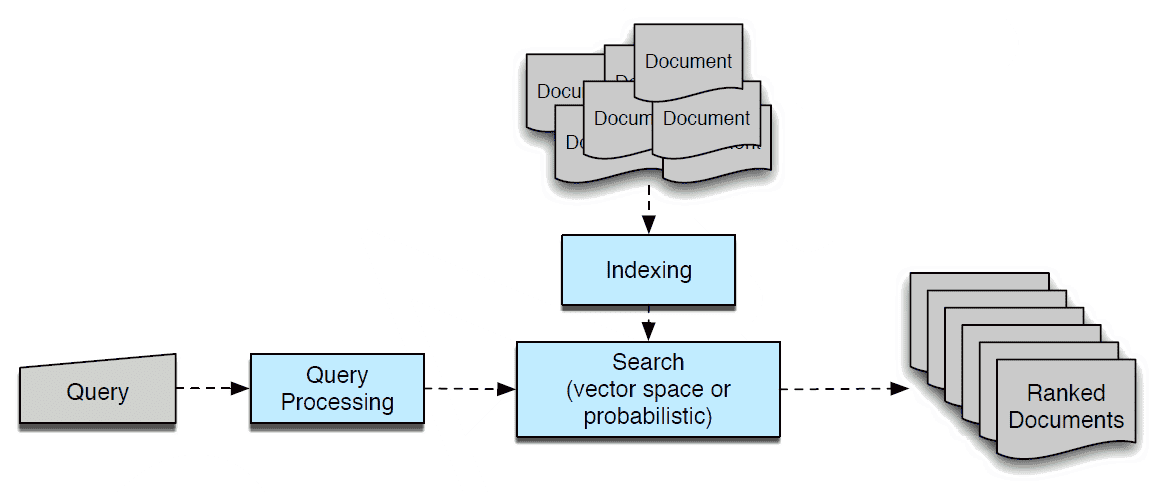|
Getting your Trinity Audio player ready...
|
Summary: The Information Retrieval system enables you to quickly find relevant information about. It goes beyond simple keyword matching by understanding the context of your query and ranking documents based on their relevance to your information needs.
Data is the new gold. It is fueling the decision-making process in the organisation. The ability to quickly and accurately retrieve relevant information has become significant for organisations. Information retrieval systems in NLP or Natural Language Processing is the backbone of search engines, recommendation systems and chatbots.
The end objective of implementing this system is to enable the users to find the most pertinent information from vast datasets. As the scope of Information Retrieval continues to grow, several new applications will be coming into the picture.
Researchers and educators have always been involved in the activity of retrieving information. Earlier, our scope of information was limited to books and research papers. But now, with the help of web browsers, information retrieval has expanded exponentially. Google and Bing are prominent examples of how well the IRS has penetrated our lives.
What goes behind the screen is what drives all the attention. Have you ever wondered how so much information floods in at just a click of a button? In this blog, we delve into the intricacies of Information Retrieval in NLP.
Key Takeaways:
- Efficient Data Retrieval: Information Retrieval in NLP ensures rapid access to pertinent information from massive datasets, enhancing user experience.
- Relevance Matters: The system’s objective is to retrieve the most relevant data to a user’s query, often considering factors beyond keyword matching.
- Structured Data: IR systems organize unstructured data into a structured format, allowing for efficient indexing and retrieval.
- Multistep Process: The IR process involves data preprocessing, indexing, query processing, and relevance ranking.
- Synergy with AI: Information Retrieval closely relates to Information Extraction, collectively fueling AI’s ability to comprehend and generate human-like responses.
What is an Information Retrieval System?
An Information Retrieval (IR) system is a software-based framework designed to retrieve relevant information efficiently and effectively from a collection of data or documents in response to user queries.
These systems are integral to various applications, such as search engines, recommendation systems, document management systems, and chatbots. The primary goal of an IR system is to bridge the gap between the user’s information needs and the available data by providing timely and accurate results.
Unlike simple keyword-based searches, modern IR systems employ advanced techniques from fields like Natural Language Processing (NLP), machine learning, and data mining to understand user intent, context, and the semantics of queries and documents. This enables them to retrieve documents that match the exact keyword and answer the user’s query.
Key features of Information Retrieval System include:
- Indexing: Creating an organized structure maps terms (words or phrases) to the documents in which they appear. This structure allows for efficient lookup and retrieval of documents based on specific terms.
- Query Processing: The system analyzes and processes user queries to identify the most relevant terms and concepts. This often involves techniques to handle synonymy (different words with the same meaning) and polysemy (a word with multiple meanings).
- Relevance Ranking: Documents retrieved from the index are ranked based on their perceived relevance to the user’s query. Various ranking algorithms, such as TF-IDF (Term Frequency-Inverse Document Frequency) and BM25, are used to determine the order in which documents are presented to the user.
- User Interaction and Feedback: Some IR systems learn from user interactions to improve their performance over time. For instance, if a user clicks on a certain search result, the system might learn that similar results are likely to be relevant.
- Information Presentation: The retrieved documents are typically presented to the user with additional information, such as document snippets, titles, and links, to help users quickly assess the relevance of each result.
- Query Expansion: This technique involves automatically enhancing user queries with additional terms related to the original query. This can help retrieve more relevant results by accounting for different ways of expressing the same idea.
- Evaluation Metrics: IR systems are often evaluated using precision, recall, and F1-score metrics, which measure how accurately the system retrieves relevant documents and avoids irrelevant ones.
- Scalability: Modern IR systems must be scalable to handle large datasets efficiently given the vast data available today.
Objectives of Information Retrieval System:
The objectives of an Information Retrieval (IR) system are centred around providing efficient and accurate access to relevant information from a vast collection of data or documents. These objectives go beyond simple keyword matching and focus on enhancing the user’s experience by delivering meaningful and contextually appropriate results. The primary objectives of an IR system include:
Relevance:
The foremost objective of an IR system is to retrieve information that is directly relevant to the user’s query. This means that the system should consider exact keyword matches, understand the user’s intent, and provide documents that address the user’s information needs.
Efficiency:
IR systems aim to retrieve relevant documents quickly, even from large datasets. Speed and efficiency are critical to providing a satisfactory user experience, especially when users expect rapid responses to their queries.
Ranking:
Once relevant documents are retrieved, the IR system ranks relevant documents in order of perceived relevance once they are retrieved. This ranking helps users prioritize their focus on the most relevant documents and saves them time by not having to sift through irrelevant results.
Accuracy:
IR systems strive to minimize false positives (irrelevant documents retrieved) and false negatives (relevant documents not retrieved). Accurate retrieval ensures that users receive trustworthy and appropriate information.
Contextual Understanding:
Beyond literal keyword matching, IR systems aim to comprehend the context and semantics of both user queries and document content. This allows the system to provide results that align with the user’s intended meaning.
User Interaction:
Many modern IR systems incorporate user interactions and feedback to improve future retrieval results. By learning from user behaviour and preferences, the system becomes better at refining its results over time.
Personalization:
In some cases, IR systems personalize results based on user profiles, preferences, and historical interactions. This ensures that users receive information most relevant to their needs.
Diversity of Results:
While relevance is crucial, IR systems also aim to provide diverse results. This prevents the system from returning multiple highly similar documents and instead offers a well-rounded view of the topic.
Adaptability:
IR systems need to adapt to changes in data and user behaviour. As new documents are added, and user preferences evolve, the system should continue to provide accurate and relevant results.
Supporting Complex Queries:
The system should handle complex queries involving multiple concepts, logical operators, and facets. It should understand and interpret these queries accurately to provide meaningful results.
Information Retrieval Process:
The Information Retrieval (IR) process involves a series of steps that collectively aim to retrieve relevant information from a collection of data or documents based on user queries. This process goes beyond simple keyword matching and employs various techniques to understand user intent, index documents, and rank their relevance. Here’s a step-by-step breakdown of the typical information retrieval process:
-
Data Collection and Preprocessing
- Gather a collection of documents or data on which the IR system will operate.
- Preprocess the raw data by cleaning, tokenizing (breaking into words or phrases), and removing unnecessary elements like stopwords and punctuation.
- Optionally, apply techniques like stemming or lemmatization to reduce words to their root forms.
-
Indexing
- Create an index that maps terms (words or phrases) to the documents they appear. This index allows for efficient lookup and retrieval.
- Various data structures, like inverted indexes, facilitate fast retrieval of documents containing specific terms.
-
Query Processing
- Analyze and process user queries to identify relevant terms and concepts.
- Handle query expansion, where additional terms related to the user query are added to enhance retrieval accuracy.
- Address synonymy and polysemy by identifying alternate terms or meanings that match the user’s intent.
-
Relevance Ranking
- Retrieve documents containing the terms from the user query.
- Calculate a relevance score for each document using ranking algorithms such as TF-IDF (Term Frequency-Inverse Document Frequency) or BM25.
- Documents with higher relevance scores are ranked higher and presented to the user first.
-
Presentation of Results
- Display the retrieved documents to the user in a user-friendly format, often including document titles, snippets, and links.
- Include additional information like publication dates, authors, and metadata to help users assess the relevance of each result.
-
User Interaction and Feedback
- Observe user interactions with the presented results, such as clicks and dwell time, to gather feedback on the relevance of the retrieved documents.
- Incorporate user feedback to refine the ranking algorithms and improve future retrieval results.
-
Iterative Querying
- Users can refine their queries based on the initial results by modifying keywords or adding filters.
- Each iteration helps the user narrow their search and improve the relevance of the retrieved documents.
-
Continuous Learning and Adaptation
- Update the index and ranking algorithms as new documents are added to the collection.
- Adapt to changes in user behaviour and preferences to improve the accuracy and relevance of future results.
Information Retrieval Example:
Imagine searching for “best budget smartphones.” An IR system would consider documents containing these words and understand the context to retrieve articles discussing affordable smartphones with good features, ensuring the results are aligned with the user’s intent.
Information Retrieval and Information Extraction in AI
Information Retrieval and Information Extraction are two pillars of AI‘s language understanding capabilities. While IR focuses on fetching relevant information from existing datasets, Information Extraction involves identifying structured information from unstructured text, contributing to AI’s knowledge base.
Wrapping it up !!!
In the realm of NLP, Information Retrieval plays a pivotal role in making sense of the vast amount of information available. It bridges the gap between human queries and data repositories, enabling efficient and accurate retrieval. As AI advances, understanding the synergy between Information Retrieval and Information Extraction becomes increasingly crucial.
Start Your Learning Journey with Pickl.AI
Are you eager to dive into the world of Data Science and AI? Explore our range of courses at Pickl.AI and embark on a journey to master the technologies shaping the future.





